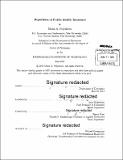| dc.contributor.advisor | Amy Finkelstein and Nancy Rose. | en_US |
| dc.contributor.author | Polyakova, Maria A. (Maria Alexandrovna) | en_US |
| dc.contributor.other | Massachusetts Institute of Technology. Department of Economics. | en_US |
| dc.date.accessioned | 2014-09-19T21:41:24Z | |
| dc.date.available | 2014-09-19T21:41:24Z | |
| dc.date.copyright | 2014 | en_US |
| dc.date.issued | 2014 | en_US |
| dc.identifier.uri | http://hdl.handle.net/1721.1/90128 | |
| dc.description | Thesis: Ph. D., Massachusetts Institute of Technology, Department of Economics, 2014. | en_US |
| dc.description | Cataloged from PDF version of thesis. | en_US |
| dc.description | Includes bibliographical references (pages 147-150). | en_US |
| dc.description.abstract | The first chapter takes advantage of the evolution of the regulatory and pricing environment in the first years of a large federal prescription drug insurance program for seniors - Medicare Part D - to explore interactions among adverse selection, switching costs, and regulation. I document evidence of both adverse selection of beneficiaries across contracts and switching costs for beneficiaries in changing contracts within Medicare Part D. Using an empirical model of contract choice and contract pricing, I show that in the present environment, on net, switching costs help sustain an adversely-selected equilibrium with large differences in risks between more and less generous contracts. I then simulate how switching costs may alter the impact of "filling" the Part D donut hole as implemented under the Affordable Care Act. I find that absent any switching costs, this regulation would have eliminated the differences in risks across contracts; however, in the presence of the switching costs that I estimate, the effect of the policy is largely muted. The second chapter (co-authored with Francesco Decarolis and Stephen Ryan) explores federal subsidy policies in Medicare Part D. We estimate an econometric model of supply and demand that incorporates the regulatory pricing distortions in the insurers' objective functions. Using the model, we conduct counterfactual analyses of what the premiums and allocations would be in this market under different ways of providing the subsidies to consumers. We show that some of the supply-side regulatory mechanisms, such as the tying of premiums and subsidies to the realization of average "bids" by insurers in a region, prove to be welfare-decreasing empirically. The third chapter studies two competing systems that comprise the German health insurance landscape. The two systems differ in the ability of insurers to underwrite individual-specific risk. In contrast to the community rating of the statutory insurance system, enrollees of the private plans face full underwriting and may be rejected by the insurers. I empirically assess to what extent the selection of "good risks" dominates the interaction between the two systems, using a regression discontinuity design based on statutory insurance enrollment mandates. I do not find compelling evidence of cream-skimming by private insurers from the statutory system. Motivated by this finding, I quantify the change in consumer welfare that would result if the government relaxed the statutory insurance mandate to lower income levels. | en_US |
| dc.description.statementofresponsibility | by Maria A. Polyakova. | en_US |
| dc.format.extent | 150 pages | en_US |
| dc.language.iso | eng | en_US |
| dc.publisher | Massachusetts Institute of Technology | en_US |
| dc.rights | M.I.T. theses are protected by copyright. They may be viewed from this source for any purpose, but reproduction or distribution in any format is prohibited without written permission. See provided URL for inquiries about permission. | en_US |
| dc.rights.uri | http://dspace.mit.edu/handle/1721.1/7582 | en_US |
| dc.subject | Economics. | en_US |
| dc.title | Regulation of public health insurance | en_US |
| dc.type | Thesis | en_US |
| dc.description.degree | Ph. D. | en_US |
| dc.contributor.department | Massachusetts Institute of Technology. Department of Economics | |
| dc.identifier.oclc | 890150129 | en_US |
